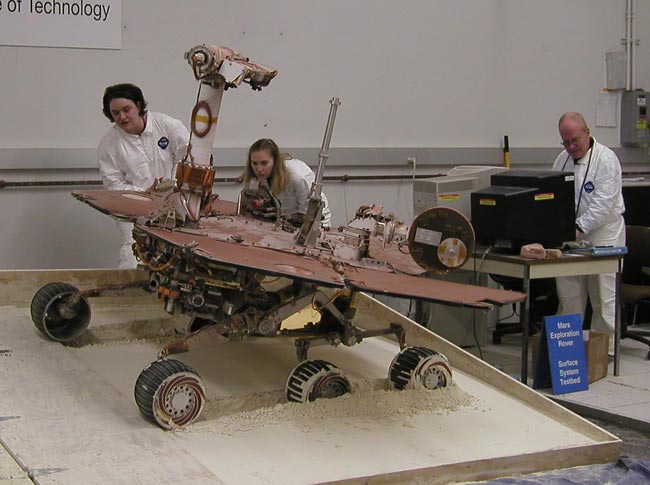Test Rover in Place, NASA Prepares to Free Spirit

Operation Free Spirit is set to begin.
Yesterday, the test rover that is an exact twin of NASA's Spirit and Opportunity rovers was set up in a plywood test rig in a dirt pit at NASA's Jet Propulsion Laboratory in Pasadena, Calif. The rig was built to allow mission engineers to mimic the situation Spirit finds itself in on Mars, with its wheels mired in the Martian sand.
"The test facility is now configured, and the rover is in place," said Steve Squyres, lead scientist for the Mars Exploration Rover Project, in an email yesterday. "The first time we turn the wheels should be today."
The test rover is now perched inside a wooden rig filled with a soil mixture concocted by mission scientists to mimic the sand Spirit's wheels are caked in. The mixture is mostly a combination of a substance called diatomaceous earth and clay. The test rover's wheels have plowed into the material, leaving ruts in their wake.
The team planned a few adjustments to more closely match Spirit's situation, such as placing a rock beneath the test rover, and then intended to begin assessing possible maneuvers for Spirit to use getting free from Troy.
Spirit has been stuck in Martian soil up to its hubcaps since May 6 when it became mired in a dirt patch (now called "Troy") while driving backward. Though it can't roam around right now, Spirit is still doing plenty of science.
If the test rover's wheels spin in the same way as Spirit's, engineers will know they have the right mixture and can start testing out maneuvers to free the rover. If they don't behave in quite the same way, the team will have to adjust the soil mixture.
Get the Space.com Newsletter
Breaking space news, the latest updates on rocket launches, skywatching events and more!
Join our Space Forums to keep talking space on the latest missions, night sky and more! And if you have a news tip, correction or comment, let us know at: community@space.com.

Andrea Thompson is an associate editor at Scientific American, where she covers sustainability, energy and the environment. Prior to that, she was a senior writer covering climate science at Climate Central and a reporter and editor at Live Science, where she primarily covered Earth science and the environment. She holds a graduate degree in science health and environmental reporting from New York University, as well as a bachelor of science and and masters of science in atmospheric chemistry from the Georgia Institute of Technology.









